Snapshot of a Mineral Collector
By
Sarah Watkins
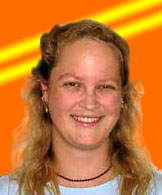
I started collecting minerals when I was 8 years old.
Whenever my parents and I would go into one of those
nifty science or education stores, I would see the nice
polished colored stones and I just wanted to own one of
each. I started collecting them and learning about them.
I’ve always liked color so when I discovered that
the same mineral can appear in many totally different
forms and colors, I wanted to know why. That spurred a
lifelong curiosity about – and love of –
minerals, my completion of a Bachelor’s Degree in
Geology and my pursuit of a Master’s Degree in
Volcanology.
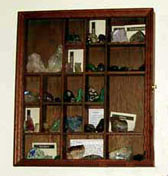 I now have over 70 different minerals in my collection,
and well over a hundred samples. I’m still
fascinated by the minerals that can take many different
forms (like Tiger’s Eye, Amethyst, Agate and
Chalcedony all being varieties of Quartz), especially the
ones that come in many colors. I don’t think
I’ll ever be able to collect enough Fluorite
– I never get tired of the colors it comes in.
I now have over 70 different minerals in my collection,
and well over a hundred samples. I’m still
fascinated by the minerals that can take many different
forms (like Tiger’s Eye, Amethyst, Agate and
Chalcedony all being varieties of Quartz), especially the
ones that come in many colors. I don’t think
I’ll ever be able to collect enough Fluorite
– I never get tired of the colors it comes in. 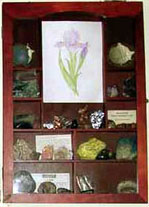 In
fact, I have two favorite samples out of all the minerals
I’ve purchased (and more out of the minerals
I’ve collected) and one of them is a fluorite
plate. The fluorite plate is rectangular and 10 cm by 15
cm and about 1.5 cm thick. In that sample is every color
I have ever seen fluorite come in: it’s striped
green and blue and purple and gray and clear and yellow.
And it’s all the same mineral! My other favorite
out of my purchased minerals is a septarian nodule.
It’s an egg shaped slab 25 cm across and 2.5 cm
thick. The middle of the egg is missing, like a broken
window, but the remaining edges are encrusted with small
amber-yellow-golden brown crystals. I bought the sample
at my first Geological Society of American conference,
and when I got home and was unloading my car, my arms
were too full and I dropped it. It broke into about 8 big
pieces and a dozen smaller ones. I’d wanted a
sample like that for years, so I was just
devastated/furious when I dropped it. Once I had calmed
down, I glued it back together and, from the polished
side of the sample, you can’t tell it was ever
broken.
In
fact, I have two favorite samples out of all the minerals
I’ve purchased (and more out of the minerals
I’ve collected) and one of them is a fluorite
plate. The fluorite plate is rectangular and 10 cm by 15
cm and about 1.5 cm thick. In that sample is every color
I have ever seen fluorite come in: it’s striped
green and blue and purple and gray and clear and yellow.
And it’s all the same mineral! My other favorite
out of my purchased minerals is a septarian nodule.
It’s an egg shaped slab 25 cm across and 2.5 cm
thick. The middle of the egg is missing, like a broken
window, but the remaining edges are encrusted with small
amber-yellow-golden brown crystals. I bought the sample
at my first Geological Society of American conference,
and when I got home and was unloading my car, my arms
were too full and I dropped it. It broke into about 8 big
pieces and a dozen smaller ones. I’d wanted a
sample like that for years, so I was just
devastated/furious when I dropped it. Once I had calmed
down, I glued it back together and, from the polished
side of the sample, you can’t tell it was ever
broken.
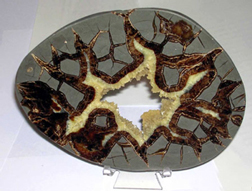
My favorite samples that I actually collected are from
New Mexico and Nevada. The sample from New Mexico is out
of a volcanic ash deposit from Mt. Taylor. I was taking a
course on field volcanology and out of our stops was a
good exposure of Mt. Taylor ash beds. There are garnet,
topaz and quartz crystals mixed in with the layers of
ash. To think that something like ash from an exploding
volcano can have garnet and topaz crystals is just the
coolest thing ever. I spent time looking for the best
sample I could find, despite waist high prickly weeds,
the threat of snakes, and the blazing hot sun overhead.
I have two favorites from Nevada: one from the Rainbow
Hills (just east of Reno) and one from near a mine in
central Nevada. The sample from the Rainbow Hills is
actually sand that I collected on a mapping trip for my
igneous petrology field methods course. But rather than
your typical beach sand, this is sand from a (very
different) volcanic ash deposit. The sand is just chock
full of bi-pyramidal quartz and sanidine. Sanidine (a
kind of feldspar) has a unique property where it distorts
light as it passes through the crystal so you see a flash
of blue inside of a clear crystal. So I’m out
walking along this saddle between two ridges, trying to
draw the rock layers accurately on my aerial photos and
topographic maps, and the sand is sparkling blue at me! I
had to take some home with me, even though the crystals
are small (2-3 mm).
The sample from near the mine in central Nevada is a
mineral called Dumortierite. It’s the most amazing
shade of purple-pink ever. I met the two gentleman who
own the land (and mineral rights) there and they’re
planning to mine the Dumortierite bearing rock for
countertops and decorative stone. Can you imagine?
Purple-pink countertops!
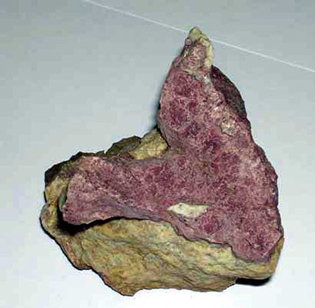
Many would consider me not to be a true collector, since
most of my samples are purchased, instead of collected by
me. At this point, I have a lot of minerals and
it’s not exactly feasible to go all over the world
to find the rare and unique minerals that are mostly the
ones missing from my collection. Besides, I learn about
each of my samples and know where they came from and how
they formed. I could tell you something cool or
interesting about every mineral in my collection and
that’s the important thing. I’m always
learning more about minerals always teaching other people
the interesting things I learn.